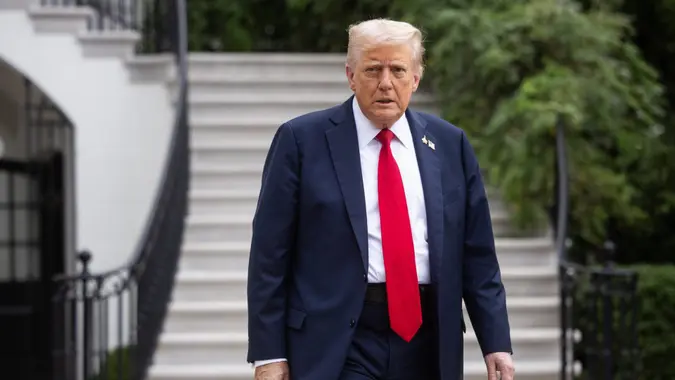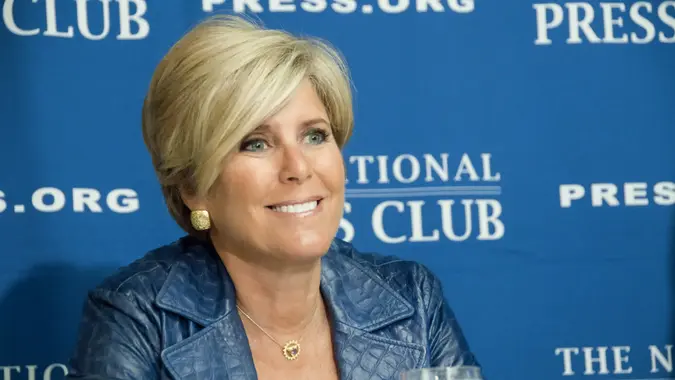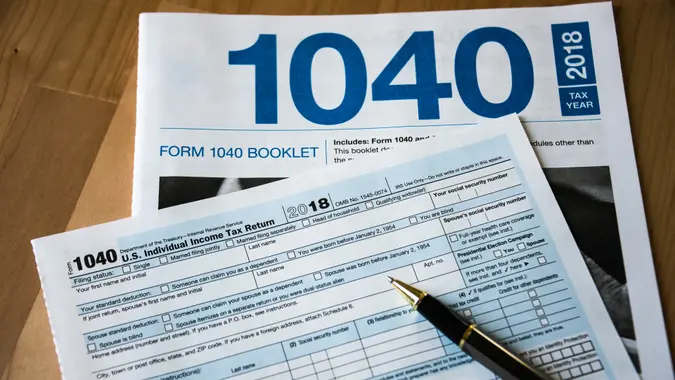How Would Trump Offer ‘Large Tax Cuts for Workers’?

Commitment to Our Readers
GOBankingRates' editorial team is committed to bringing you unbiased reviews and information. We use data-driven methodologies to evaluate financial products and services - our reviews and ratings are not influenced by advertisers. You can read more about our editorial guidelines and our products and services review methodology.

20 Years
Helping You Live Richer

Reviewed
by Experts

Trusted by
Millions of Readers
Republican presidential nominee Donald Trump’s recently unveiled Republican Party Platform decried President Joe Biden’s policies and upheld Trump’s classic slogan to “make America great again.” The platform lists 20 points to help strengthen the American public. One of the points on the plan that might stick out to the average American worker stated, “Large tax cuts for workers. And no tax on tips!”
It’s one thing to put something in your platform, but it’s another to lay out a strategy to make it happen. GOBankingRates reached out to experts to see exactly how the Trump administration could make tax cuts a reality for American workers.
Make the Tax Cuts and Job Act Permanent
During Trump’s presidency in 2017, he put forward the Tax Cuts and Job Act (TCJA). The act lowered most individual income tax rates, and increased the standard deduction. Additionally, TCJA increased the amount received for the child tax credit. However, TCJA is set to expire at the end of 2025.
Dr. Jim Ronan, a lecturer in the department of political science at Villanova University, said that by extending the TCJA, workers could see these tax cuts continue.
“The large tax cut pledge is heavily based on making the 2017 tax cuts permanent,” Ronan said. “These cuts are due to expire in 2025, and according to the GOP Platform, allowed for an expansion of the child tax credit and doubled the standard deduction. Thus, if these proposals are renewed, workers may not notice much of a change. However, if they are allowed to lapse, taxpayers could be in for an unpleasant surprise when their 2025 returns are due.”
Adjusting Tax Brackets
When Trump enacted TCJA, taxation percentages correlated with certain pre-established income brackets. However, if those brackets were widened, certain classes might be able to experience a lighter tax burden.
“One way to reduce the tax burden on employees is through adjusting the tax brackets,” said Ariful Islam, a finance expert at Sterlinx Global. “This might entail decreasing the rate of taxes for middle-class and low-income families or increasing their income thresholds, thereby making more people enjoy lesser rates of taxation.”
Increasing the Standard Deduction
TCJA already increased the standard deduction back in 2017 — e.g., from $6,500 to $12,000 for single filers.
Trump could double down and increase it even more, which would be advantageous to a lot of taxpayers.
“Most workers’ taxable incomes can be backed down by this president’s increase in standard deductions,” Islam said. “It was effectively utilized in 2017, whereby it was included as part of TCJA, and could even become broader to give more relief.”
Expanding Tax Credits
Islam said there’s an opportunity for the Trump administration to increase the child tax credit again, or for there to be additional tax credits added that taxpayers can benefit from.
“Another approach would include expanding on already existing tax credits such as the earned income tax credit (EITC) or coming up with new ones that target families who are working,” he said. “Apart from being a strategy that lowers taxes, this equally supports household revenues, hence stimulating overall economic activities.”
Revisiting Payroll and Social Security Taxes
If you look at your paycheck, you’ll see certain taxes such as FICA. Islam said there’s an opportunity for Trump to restructure how this is done in order to give more money back to taxpayers.
“Reducing payroll taxes [could] provide an immediate relief to workers by raising take-home wages,” Islam said. “It can thus be effective, especially when it directly affects what they receive in terms of pay without necessarily significantly altering their tax returns.”
Trump has floated the idea of not taxing Social Security benefits as well.
Michael Montgomery, an intermittent lecturer in the department of health and human services at University of Michigan-Dearborn, said that could give workers a big financial boost.
Said Montgomery: “With more and more Americans working at least part time while also drawing Social Security, [Trump’s] proposal to exempt Social Security payments from federal taxes would, if enacted, certainly be a benefit to those workers.”
Deficit Spending
One of the main reasons Jim Miller, author at Tangent Consulting, said TCJA was able to succeed was because the government was spending more than it was making.
“The funding was done mainly through increased deficit spending,” Miller said. “In addition, some provisions were aimed to broaden the tax base by removing certain deductions like putting a lid on state and local tax deductions. This helped to increase the funding.”
Miller said this is one way more tax cuts could be coming workers’ way, but it’s not ideal.
“The Committee for a Responsible Federal Budget suggests that Trump tax cut plans can add $150 billion to $250 billion into the current deficit for the next 10 years. So, although increased deficit spending can get the job done for President Trump, this won’t help in the longer run and can add more misery to the current deficit.”
Economic Growth and Fiscal Management
To avoid dramatically increasing the deficit while still giving money back to Americans, Trump has to strike a delicate balance.
“To address the revenue losses from the tax cuts, the promotion of economic growth is key,” Islam said.
He went on to say that there are a variety of ways Trump can try to stimulate the economy.
“Through implementing policies which encourage investment, job creation and expansion of businesses, the overall amount collected in taxes can increase, hence offsetting fiscal impacts.”
Ultimately, lots of strategy is required for Trump to be successful at providing tax cuts for workers without there being a lot of financial fallout.
“The success of these measures will depend on careful planning, broad legislative backing and a focus on stimulating economic growth,” Islam said.
Editor’s note on election coverage: GOBankingRates is nonpartisan and strives to cover all aspects of the economy objectively and present balanced reports on politically focused finance stories. You can find more coverage of this topic on GOBankingRates.com.
More From GOBankingRates
 Written by
Written by  Edited by
Edited by 

























